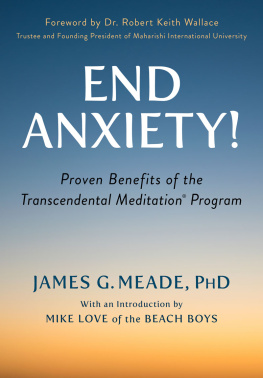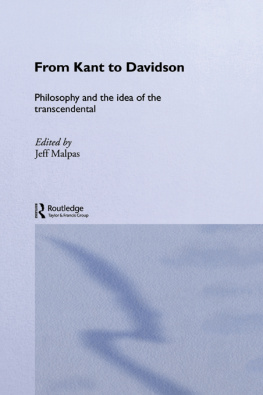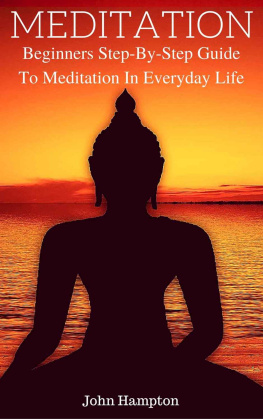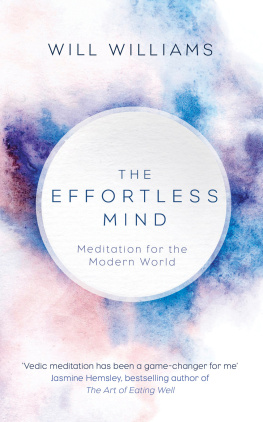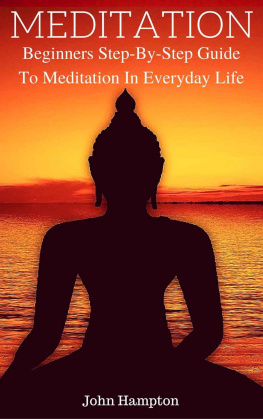Thank you for downloading this Simon & Schuster ebook.
Get a FREE ebook when you join our mailing list. Plus, get updates on new releases, deals, recommended reads, and more from Simon & Schuster. Click below to sign up and see terms and conditions.
CLICK HERE TO SIGN UP
Already a subscriber? Provide your email again so we can register this ebook and send you more of what you like to read. You will continue to receive exclusive offers in your inbox.
For Teachers of Transcendental Meditation
INTRODUCTION
Picture someone who teaches meditation, and I am probably not that person. I am often dressed in a suit, for one, and my offices are in Midtown Manhattan. I am not at all New Agey. I am a natural skeptic, and I am even more obsessed with science than I am with baseball, which is to say, very . I am not into woo-woo stuff. My friends have a running joke about me: How can a vegetarian be such a meat-and-potatoes guy? I like things to be simple, practical, and thoroughly, unassailably logical.
And for more than forty-five years, teaching the Transcendental Meditation technique has been my full-time job. The technique comes from the oldest continuous meditation tradition in the world. There is no philosophy, change in lifestyle, or religion involved in its practice. For well over five thousand years, the TM technique was passed down from teacher to student, one to one: never in groups, never from a book. It has roots in the ancient noble warrior classes, where acting out of fear or anger brought disaster and defeat. Today it is for all of us who seek greater balance in life as well as more creativity, better health, less stressand happiness.
Over those thousands of years, the TM technique has been honed to twenty minutes, twice a day: once in the morning, ideally before breakfast; and again in the late afternoon or early evening, ideally before dinner. You learn this meditation from a professionally trained teacher who will instruct you in a one-to-one session. He or she will give you your own mantraa word or sound that has no meaning associated with itand teach you how to think it properly, which means easily, effortlessly, and silently. Youll learn that you dont need to push out thoughts, or watch your breath, or monitor sensations in your body, or visualize anything. Youll also learn that there is no need to sit in any particular position. You can sit up comfortably in a chair at home, at work, on a train or plane; on a park benchbasically, wherever its comfortable. The morning session wakes up your brain and gives you energy and resilience so that the demands and challenges of the day dont stress you out. Then you meditate once again, ideally in the late afternoon or early evening before dinner, to start the next part of your day fresh. Twice a day, TM gives you a reset.
I have taught many thousands of people to meditate. My students are the leaders of Fortune 100 companies and are cashiers in small family shops. They go to private colleges and urban schools. They are Christians, Jews, Buddhists, Muslims, and Hindus, or they practice no religion whatsoever. They run the gamut from professional athletes to people living in homeless shelters. Whomever I am sitting across fromwhether its a CEO of one of the worlds largest financial institutions or a single working mom with two young children at home or a veteran who hasnt slept more than two hours a night for monthsthey have the same look in their eyes when they come to me to talk about meditation. They are ready for something better, they are ready for a change.
I was in their shoes once, and I was perhaps more skeptical than any of them. In 1969 I was a university student with a nagging sense that there had to be something more I could be doing to be happier, healthier, more productive. I saw far too many people who had acquired the things that are supposed to make you that way, and yet they were often too stressed with too much worry, and, too often, unhappy. A friend whom I trusted, who had observed my own spiking stress levels from too much school pressure, suggested I might like Transcendental Meditation. I balked. I wasnt interested. Meditation wasnt even a word in my vocabulary. I was (and am) a very practical, down-to-earth, active kind of a guy. My trajectory was to go to law school so that I could run for public office and ultimately become a US senator. I wanted to help change the world. (Yes, we thought those things then.) Sitting around meditating didnt fit into my life view.
But I wasnt sleeping well, and my memory was flagging, and I did respect my friends opinion, so I decided to at least give TM a try. Despite my initial reticence and skepticism, I found the experience to be marked, significant, real. It was astonishingly easy to do, deeply relaxing, and yet incredibly energizing, like nothing I had experienced before. From the very start, I knew that, somehow, I wanted to teach this to people; and, in particular, I wanted to teach it to inner-city school kids. A few years later, in January 1972, I took a semester off from my studies and enrolled in a graduate-level five-month TM teacher training course led by Maharishi Mahesh Yogi, himself a university-trained physicist and the foremost meditation teacher of this generation. During the course, Maharishi and a team of brain scientists, physicians, and psychologists explored ancient and modern insights into the science of consciousness, as well as the impact of stress and trauma on the brain and nervous system. We learned the unique mechanics of the TM practice and the role of this meditation for unfolding the seemingly limitless creativity and intelligence within the human mind, as well as its ability to address effectively many of societys intractable ills. Most importantly, Maharishi taught us the simple yet precise technique of how to personally teach any individual to transcend to effortlessly access the deep stillness that lies within every human beingin a way that was tailored specifically for that person.
From his earliest days of teaching TM in the world in 1958, Maharishi focused on researching and understanding the science of Transcendental Meditation. He challenged doctors at Harvard, UCLA, and other medical schools to study the neurophysiological changes both during and after the technique. The results are abundantly clear today. Since then, more than four hundred scientific studies have shown the wide-ranging benefits of the TM technique for improving brain and cognitive functioning, cardiovascular health, and emotional well-being. These studies have been published in top peer-reviewed science journals, including the American Medical Associations JAMA Internal Medicine , and the American Heart Associations journals Stroke and Hypertension . (To be clear, it matters greatly that this research is peer-reviewed. Medical peer review means that experts are evaluating the credibility of the study, and also ensuring that the clinicians involved meet established standards of care.) The US National Institutes of Health has provided tens of millions of dollars to study TMs effects on stress and heart health, while the US Department of Defense has awarded several million dollars to study its impact on post-traumatic stress disorder (PTSD) in veterans returning from combat in Iraq and Afghanistan.
The change has taken time, but the Transcendental Meditation technique is now recognized as a powerful treatment and preventative modality for so many of the stress-based disorders of our timeas well as an immensely practical tool to markedly improve health and performance. In the same way that we now recognize the importance of exercise and eating healthy, the world has come a long way with regards to understanding the critical importance of meditation in general and Transcendental Meditation in particular.
Next page


